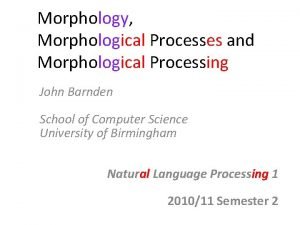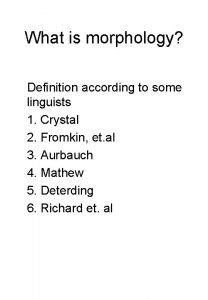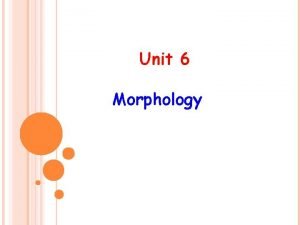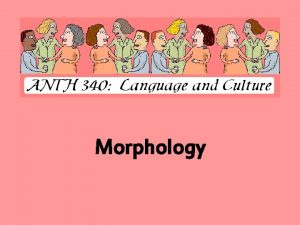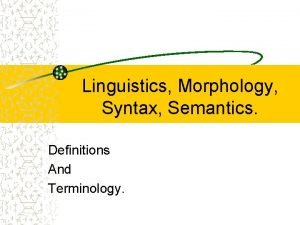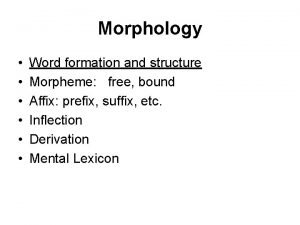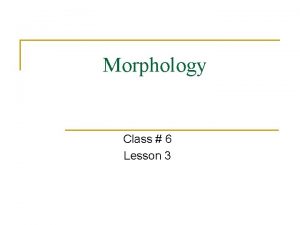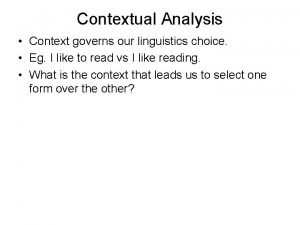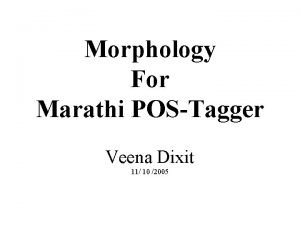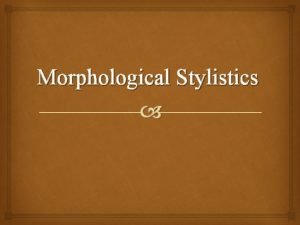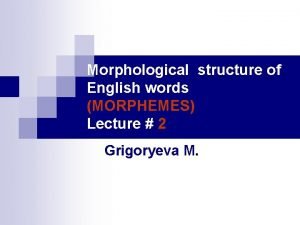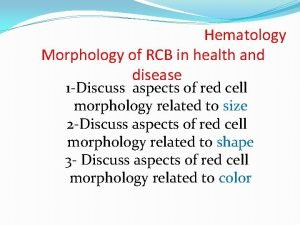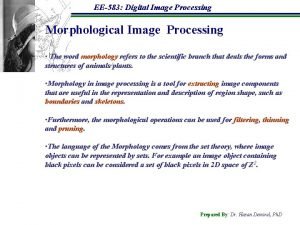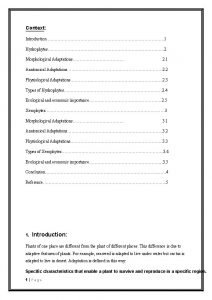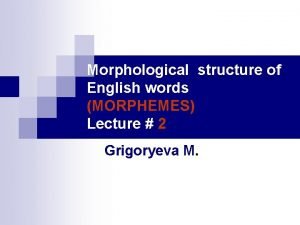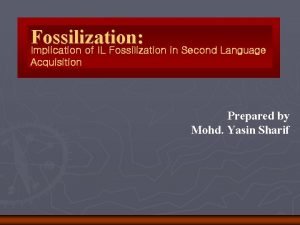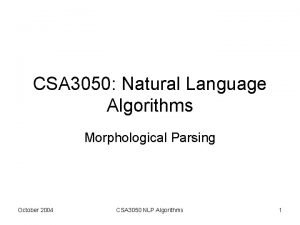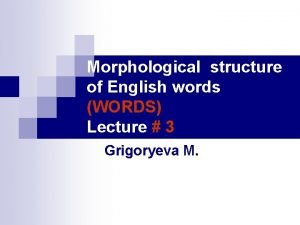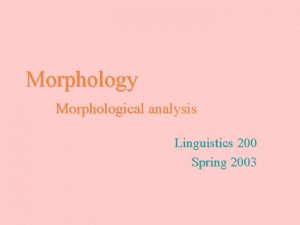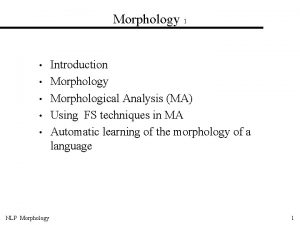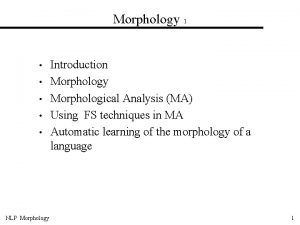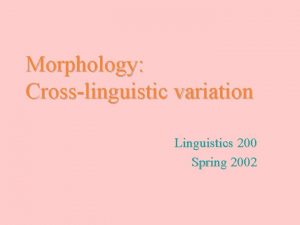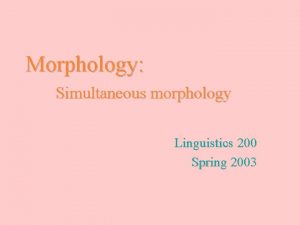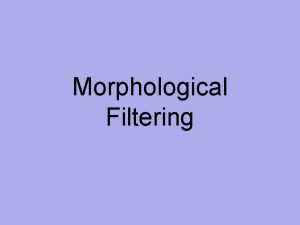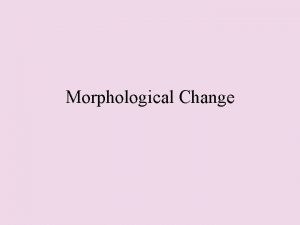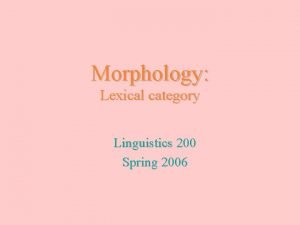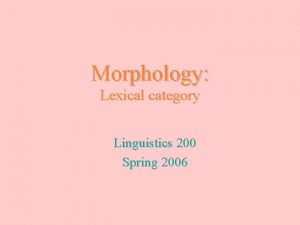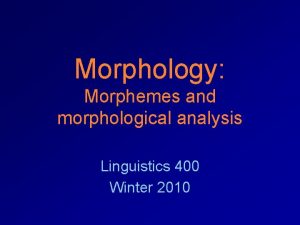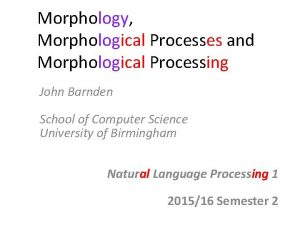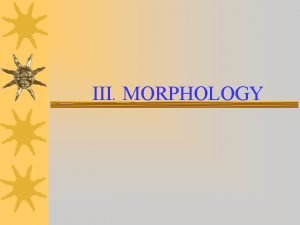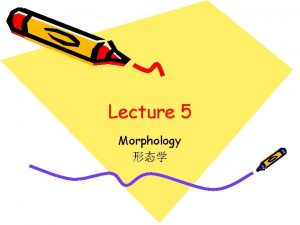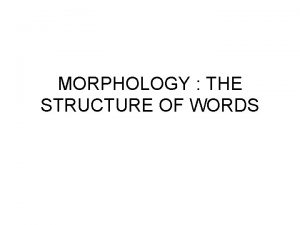Morphology Morphological analysis Linguistics 200 Spring 2006 Announcements






![Another new word • • Sequim [skw. Im] Sign as you drive out of Another new word • • Sequim [skw. Im] Sign as you drive out of](https://slidetodoc.com/presentation_image/0fe0d63f5f998a35f8db677882f0fe78/image-7.jpg)







![Morpheme syllable transcribed # morphemes # syllables paw [p. A] 1 1 par [p. Morpheme syllable transcribed # morphemes # syllables paw [p. A] 1 1 par [p.](https://slidetodoc.com/presentation_image/0fe0d63f5f998a35f8db677882f0fe78/image-15.jpg)








![Virginia Beavert digging [pja í] ‘bitterroot’ above [wiin. A As] (Wenas), Apr 03 Virginia Beavert digging [pja í] ‘bitterroot’ above [wiin. A As] (Wenas), Apr 03](https://slidetodoc.com/presentation_image/0fe0d63f5f998a35f8db677882f0fe78/image-24.jpg)

![Sahaptin short vowels high low front central back [tít]- ‘fart’ [ t t] t] Sahaptin short vowels high low front central back [tít]- ‘fart’ [ t t] t]](https://slidetodoc.com/presentation_image/0fe0d63f5f998a35f8db677882f0fe78/image-26.jpg)
![Sahaptin short vs. long vowels short long [pišíš] ‘paternal aunt’ [c íiš] ‘water’ [pjúš] Sahaptin short vs. long vowels short long [pišíš] ‘paternal aunt’ [c íiš] ‘water’ [pjúš]](https://slidetodoc.com/presentation_image/0fe0d63f5f998a35f8db677882f0fe78/image-27.jpg)

![Sahaptin ejectives [q’] = uvular ejective n [q’] in Sahaptin n n [q’A nu] Sahaptin ejectives [q’] = uvular ejective n [q’] in Sahaptin n n [q’A nu]](https://slidetodoc.com/presentation_image/0fe0d63f5f998a35f8db677882f0fe78/image-29.jpg)













![More Sahaptin words [t’] = alveolar ejective, [ ] = voiceless lateral fricative ipnúšA More Sahaptin words [t’] = alveolar ejective, [ ] = voiceless lateral fricative ipnúšA](https://slidetodoc.com/presentation_image/0fe0d63f5f998a35f8db677882f0fe78/image-43.jpg)


![Compounding • • [root] English exx. : noun verb adjective noun tray table gift Compounding • • [root] English exx. : noun verb adjective noun tray table gift](https://slidetodoc.com/presentation_image/0fe0d63f5f998a35f8db677882f0fe78/image-46.jpg)


![Allomorphs Distribution of allomorphs of English plural suffix: sibilant___ voiceless___ voiced___ -[ z] -[s] Allomorphs Distribution of allomorphs of English plural suffix: sibilant___ voiceless___ voiced___ -[ z] -[s]](https://slidetodoc.com/presentation_image/0fe0d63f5f998a35f8db677882f0fe78/image-49.jpg)



![n What about other vowels? ([ ], [u]) No morpheme ends in [ ] n What about other vowels? ([ ], [u]) No morpheme ends in [ ]](https://slidetodoc.com/presentation_image/0fe0d63f5f998a35f8db677882f0fe78/image-53.jpg)

![Deciding between the analyses n -[ji] adjectival n [t. A Atp. Asji] ‘wearing a Deciding between the analyses n -[ji] adjectival n [t. A Atp. Asji] ‘wearing a](https://slidetodoc.com/presentation_image/0fe0d63f5f998a35f8db677882f0fe78/image-55.jpg)

- Slides: 56

Morphology Morphological analysis Linguistics 200 Spring 2006

Announcements and reminders Quiz about morphology now open, closes Fri noon n Phonology homework due Thursday at beginning of section. Work from. pdf only from now on. n

Overview of morphology unit General concepts, morphological analysis (today) n Part of speech (a. k. a. grammatical category, lexical category) (Fri) n Different types of morphology (Mon) n

Morphological competence • What native speakers know about well-formed words • Understand meaning of words, including novel ones • “Prevent Los Angelization Now” (PLAN)

San Diego Earth Times Apr 2000 The drive to Los Angelization by Carolyn Chase Over the years, we've heard a lot about "Los Angelization. " The last round of managed growth sentiment in San Diego was epitomized in the 80 s by PLAN (Prevent Los Angelization Now). While PLAN fizzled, the use of "Los Angelization" still resonates with San Diegans as an epithet…

Morphological competence • Includes: • Understanding properties of words • appropriate context for use (part of speech) ‘we’ve heard about Los Angelization’ • The PLAN group wants to stop Los Angelization of this area. • *Developers want to Los Angelization this area. (Developers want to Los Angelize this area. ) •
![Another new word Sequim skw Im Sign as you drive out of Another new word • • Sequim [skw. Im] Sign as you drive out of](https://slidetodoc.com/presentation_image/0fe0d63f5f998a35f8db677882f0fe78/image-7.jpg)
Another new word • • Sequim [skw. Im] Sign as you drive out of town • “Thanks for Sequimming”

New usage of a word • “Kinko’s, the new way to office” • advertising slogan used around 1996 • "An integral part of Kinko's marketing strategy, The new way to office. TM, calls for more aggressive use of computer and digital technologies to link customers whenever and wherever they are conducting business, " said Dan Frederickson, Kinko's President…

Reaction to “to office” n n Re: "The new way to 'office'"? ? ? ---------- ORIGINAL MESSAGE TEXT ----------Have any of you noticed the new Kinko's ad slogan -- "The new way to office"? "Office" as a verb? I guess it's just an advertising thing, and it did catch my attention. I'm generally in favor of verbizing nouns where a useful purpose is served, and I am part of their "small office, home office" target market. But, this new verb they are proposing sounds so odd. I suppose you could argue that it is specific to white-collar work, while the verb "work" is non-specific. n ---------- END OF ORIGINAL MESSAGE – But what does "office" as a verb mean? Does it mean "to photocopy stuff? " Maybe "send memos and letters? " If using a noun as a verb is just an inventive way to get a point across, I might not squirm too much. But that! "The new way to office" doesn't mean a darn thing to me

n To be honest, I really didn't have a problem understanding what this means. . . or at least what I think it means. I take it that "to office" is to do the things that I'd do at my company office. To use Kinko's for the things that I know they do is to use them for photocopying, faxing, scanning, DTP, word processing, sending and receiving mail and packages, direct mail programs, mailing list maintenance, etc. It's kind of a takeoff on the verb to work. However, "to office" would mean only the type of work that you would perform in an office environment as opposed to a factory or manufacturing setting. I MAY have a little more understanding of the concept than some since except for my current situation, I worked in home offices for more than 10 years. . . and that's the target audience. If you've (and I'm not refering to you as "you", but to the collective you) never used a home office, then you aren't going to use them as much as home office users would, so they don't care if you know what they are talking about or agree with their terminology. Besides. . it's advertising. The goal is not to use correct terminology. The goal is to use terminology that gets the point across. The goal is to have you remember the name and discuss it with others. They've succeded. . . no?

Morphology is about words… • • But what’s a word? Problems with white space definition • • Inconsistency in languages with writing systems Variable spelling of compounds in (e. g. ) English • • • feedback road rage time-depth Not a possible test in languages without writing systems Fortunately, there are other tests for what is a word • A syntactic test. (Some) words can be an answer to question: • • • what did we just witness? road rage what do I need most right now? feedback what is the term in historical linguistics for estimated time from modern languages to ancestor language? time-depth

Words vs. morphemes • Morpheme: largest form (sound, gesture) associated with a particular meaning associated with a particular § [fl. Awr ]

Examples of morphemes (English) pause 1 morpheme: pause paws 2 morphemes: paw, -s paw – paws troop – troops judge – judges etc.

Caveat: morphemes vs. syllables n n n Morphemes can be identified from comparison of sets of words, not from inherent phonological shape or length Ch. 7: “Words are composed of one or more syllables. ” What’s a syllable anyway? n n An abstract phonological unit consisting of a vowel (or segment functioning as a vowel) and perhaps one or more consonants Count number of syllables in a word by counting vowels (or segments functioning as vowels)
![Morpheme syllable transcribed morphemes syllables paw p A 1 1 par p Morpheme syllable transcribed # morphemes # syllables paw [p. A] 1 1 par [p.](https://slidetodoc.com/presentation_image/0fe0d63f5f998a35f8db677882f0fe78/image-15.jpg)
Morpheme syllable transcribed # morphemes # syllables paw [p. A] 1 1 par [p. Ar] 1 1 pause [p. Az] 1 1 paws [p. Az] 2 (paw, -s) 1 pawer [p. Ar ] 2 (paw, -er) 2 cf. write, writer think, thinker pause, pauser

How many morphemes are there in ‘to Sequim’? 1. 2. 3. 4. one two three four

Free vs. bound morphemes n free: can stand alone as word n certain, able, carton, finch, pinch, sycamore n bound: must be attached to some other morpheme to form a word n representation includes hyphen n some bound morphemes in English -s, -es (-/z/) plural n -ize (-/Ajz/) ‘to cause to become’ n un- (/ n/-) negative n

In Los Angelization 1. 2. 3. -ation is a free morpheme. -ation is a bound morpheme. Los Angeles is a bound morpheme.

Root vs. affix morphemes n Roots n n meaning: contains major (referring, lexical) component of word meaning phonological shape: typically have longer, more complex shapes than affixes (but not always) can be bound or free morphemes one (or more) root morphemes per word (basically) n e. g. flower is a word which consists of one morpheme, which is a root morpheme

Affixes § Affix types § Prefixes--added before another morpheme § § Suffixes---added after another morpheme § § § / n/- negative -/Ajz/ ‘to cause to become’ -/z/ plural Infixes---added within a root § an ex. from English pp. 79 -80

In the word flowers 1. 2. 3. There is one root morpheme and one affix morpheme. There are two root morphemes. There are two affix morphemes.

How to tell what is a morpheme? n n An example of morphological analysis: Sahaptin Examples of two word formation strategies in Sahaptin n Affixation Compounding (First, some background information on Sahaptin)

Sahaptin language area
![Virginia Beavert digging pja í bitterroot above wiin A As Wenas Apr 03 Virginia Beavert digging [pja í] ‘bitterroot’ above [wiin. A As] (Wenas), Apr 03](https://slidetodoc.com/presentation_image/0fe0d63f5f998a35f8db677882f0fe78/image-24.jpg)
Virginia Beavert digging [pja í] ‘bitterroot’ above [wiin. A As] (Wenas), Apr 03

Vowel system high low front central back i ii u uu A AA [ ] = high central unrounded vowel [ii] = [i: ] = long high front unrounded vowel etc.
![Sahaptin short vowels high low front central back tít fart t t t Sahaptin short vowels high low front central back [tít]- ‘fart’ [ t t] t]](https://slidetodoc.com/presentation_image/0fe0d63f5f998a35f8db677882f0fe78/image-26.jpg)
Sahaptin short vowels high low front central back [tít]- ‘fart’ [ t t] t] ‘tooth’ [ tút] ‘your dad’ [t. A ki] ‘turkey’ [A], more narrowly transcribed, would be [ ] is transcriptional symbol for stress
![Sahaptin short vs long vowels short long pišíš paternal aunt c íiš water pjúš Sahaptin short vs. long vowels short long [pišíš] ‘paternal aunt’ [c íiš] ‘water’ [pjúš]](https://slidetodoc.com/presentation_image/0fe0d63f5f998a35f8db677882f0fe78/image-27.jpg)
Sahaptin short vs. long vowels short long [pišíš] ‘paternal aunt’ [c íiš] ‘water’ [pjúš] ‘snake’ [púuš] ‘juniper’ [sts’A t] ‘night’ [sts’A At] ‘dark’ Note quality difference between [A], [AA]

Sahaptin consonants labial alveolar stops p p’ t t’ affricates ts ts’ lateral t t ’ fricatives s lateral nasals m labio-velar uvular q q’ qw qw’ x w h č č’ š j l labio-uvular glottal k k’ kw kw’ xw n approxim ants lateral palatal velar w
![Sahaptin ejectives q uvular ejective n q in Sahaptin n n qA nu Sahaptin ejectives [q’] = uvular ejective n [q’] in Sahaptin n n [q’A nu]](https://slidetodoc.com/presentation_image/0fe0d63f5f998a35f8db677882f0fe78/image-29.jpg)
Sahaptin ejectives [q’] = uvular ejective n [q’] in Sahaptin n n [q’A nu] ‘sharp-tailed grouse’ [q’ ni] ‘torn’ cf. Witsuwit’en [q’] n [q’ ] ‘backwards’

Morphological analysis n How? n Compare two or more words which differ minimally in form and meaning n n Pairwise comparison best Identify largest form associated with a particular meaning Ø morpheme

Some Sahaptin verbs s nwišAAš ‘I’m talking’ An. A wi wišAAš ‘I’m hungry’ k. A AmšAAš ‘I miss’ (something)

Pairwise comparison s nwišAAš ‘I’m talking’ An. A wi wišAAš ‘I’m hungry’ Difference must be ‘talk’ vs. ‘be hungry’ s n ‘talk’ wišAAš ‘I (am)’ (present) An. A ‘be hungry’ k. A AmšAAš ‘I miss’ Revised analysis: s nwi ‘talk’ šAAš ‘I (am)’ (present) An. A wi ‘be hungry’ k. A Am ‘miss’

More Sahaptin verbs A verb paradigm s nwišAAš ‘I’m talking’ s nwišAAm ‘you’re talking’ is nwišA ‘he/she is talking’ s nwišAt. Aš ‘we’re talking’ s nwišAp. Am ‘you (pl. ) are talking’ p. As nwišA ‘they’re talking’

Person/number affixes -Aš ‘I’ -Am ‘you’ i- ‘he/she’ -t. Aš ‘we’ -p. Am ‘you (pl. )’ p. A- ‘they’

Person/number affixes number person sg. pl. 1 -As -t. Aš 2 -Am -p. Am 3 i- p. A-

More Sahaptin verbs An. A wi ‘I’m hungry’ wišAAš An. A wi wišAn. AAš ‘I was hungry’ An. A wi ‘I’m usually hungry’ wi AAš An. A wi wi An. AAš ‘I used to be hungry’ s nwi ‘I’m talking’ nwišAAš s nwi AAš ‘I usually talk’ s nwi ‘I was talking’ nwišAn. AAš s nwi ‘I used to talk’ nwi An. AAš

• s nwišAAš ‘I’m talking’ is nwišA ‘he’s talking’ s nwi AAš ‘I usually talk’ s nwišAAš vs. is nwišA -Aš ‘I’, i- ‘he’ • s nwi AAš vs. s nwišAAš - A ‘usually’, -šA present

s nwi AAš ‘I usually talk’ s nwi An. AAš ‘I used to talk’ s nwišAn. AAš ‘I was talking’ s nwi AAš vs. s nwi An. AAš - A-Aš ‘usually’-‘I’ - A-n. A-Aš ‘usually’-past-‘I’

What is Sahaptin -šA? n ‘present’ usage (without -n. A) actually incomplete, ongoing activity or state Ø n n n imperfective aspect šA-n. A (imperfective-past) (incomplete activity/state in the past) Tense: time of an event/state (relative to some other time); typically present, past, future Aspect: other characteristic of event/state n n n complete: perfective incomplete: imperfective relevance to later time: perfect

Summary of morphological analysis n Roots (content morphemes) s nwi ‘talk’ n An. A wi ‘be hungry’ n k. A Am ‘miss’ n n Suffixes (functional (grammatical) morphemes) -šA imperfective n - A ‘usually’ (habitual) n -n. A past n -Aš ‘I’ (first person singular) n

More Sahaptin verbs An. A wišAAm ‘you’re hungry’ i An. A wišA ‘he/she is hungry’ An. A wišAt. Aš ‘we’re hungry’ An. A wišAp. Am ‘you (pl. ) are hungry’ p. A An. A wišA ‘they’re hungry’ p. AjúwišAAm ‘you’re sick, hurt’ p. AjúwišAAš ‘I’m sick, hurt’ p. AjúwišA ‘they’re sick, hurt’ p. Apnúša ‘they’re sleeping’

More morphemes p. Ajúwi- ‘be sick, hurt’ pnú- ‘sleep’
![More Sahaptin words t alveolar ejective voiceless lateral fricative ipnúšA More Sahaptin words [t’] = alveolar ejective, [ ] = voiceless lateral fricative ipnúšA](https://slidetodoc.com/presentation_image/0fe0d63f5f998a35f8db677882f0fe78/image-43.jpg)
More Sahaptin words [t’] = alveolar ejective, [ ] = voiceless lateral fricative ipnúšA ipnút. A ipnún. A ‘he/she/it is sleeping’ ‘he/she/it will sleep’ ‘he/she/it slept’ pnún. AAm pnut’A w. AAs pnu A pnun. A w. AšAn. A p. Aw. A šAšA w. AšAt’A w. AAs ‘you slept’ ‘bed’ ‘sleeper, one who sleeps’ ‘insomniac’ ‘wild horse’ ‘they’re riding’ ‘saddle’

New morphemes w. A šA ‘ride’ n -ta ‘will’ (future) n -t’A w. AAs (instrument by which) n - A ‘one who’ (agent) n -n. A ‘that which does not (verb), that which is not (verbed)’: ‘that which (one) does not’ (negative agent) n

More words with -t’A w. AAs s. Ap’in. A wi wi ‘measure’ s. Ap’in. Awit’A w. AAs ‘ruler, measuring tape, etc. ’ tw. A luu ‘fish w/ dipnet’ tw. Aluut’A w. AAs ‘dipnet pole’ q’íwi ‘play’ q’iwit’A w. AAs ‘toy’ p. An. A ti ti ‘ascend, go p. An. Atit’A w. AAs up’ l. A q. Aj i ‘shine’ l. Aq. Aj it’A w. AAs ‘light, lamp, etc. ’ s. AAlí ‘cut with scissors’ s. AAlit’A w. AAs ‘scissors’ ‘ladder’
![Compounding root English exx noun verb adjective noun tray table gift Compounding • • [root] English exx. : noun verb adjective noun tray table gift](https://slidetodoc.com/presentation_image/0fe0d63f5f998a35f8db677882f0fe78/image-46.jpg)
Compounding • • [root] English exx. : noun verb adjective noun tray table gift wrap skin-deep verb thinktank ? ? adjective high school dry-clean red-hot

Some compounds in Sahaptin compound meaning root 1 root 2 k’t t pšw. A ‘shale’ k’t t ‘solid, hard’ pšw. A ‘rock’ p. A p t mn. A ‘palm of hand’ p. A p ‘hand, arm’ t mn. A ‘heart’ čilwit w. Apsú ‘devil’ čilwít ‘bad’ w. Apsú ‘scholarly’ nč’i stí ‘awl, ice pick’ nč’í ‘big’ stí ‘metal’

Allomorphs of a morpheme A morpheme may have more than one phonological shape. The different shapes are often predictable from context. Examples from English: plural suffix and past tense suffix, discussed in Ch. 7. -[ z] -[s] -[z] [f. Inc z] [kæts] [d. Agz] [pr s z] [s. Aks] [šuz] [d f. End nts] [lojr z]
![Allomorphs Distribution of allomorphs of English plural suffix sibilant voiceless voiced z s Allomorphs Distribution of allomorphs of English plural suffix: sibilant___ voiceless___ voiced___ -[ z] -[s]](https://slidetodoc.com/presentation_image/0fe0d63f5f998a35f8db677882f0fe78/image-49.jpg)
Allomorphs Distribution of allomorphs of English plural suffix: sibilant___ voiceless___ voiced___ -[ z] -[s] -[z] English sibilants = [s z š ž c ]

Underlying representation The forms of the English plural suffix are predictable from context. n The plural suffix has a basic representation: -/z/ n Phonology n • /z/ [s] / voiceless___ /z/ • Ø [ ] / sibilant ___ sibilant

Allomorphs • Phonological rules can convert one phoneme into another • e. g. /z/ [s] / voiceless___ e. g. /z/ • with such rules, different morphemes almost always involved: morphophonemic rules • Morphology (plural suffix) /kæt-z/ Phonology (voicing assimilation) s Phonetic representation [kæts]

Sahaptin allomorphs n Allomorphs of the dual suffix mj. A n. Aš ‘child’ mj. A n. Ašin ‘two children’ Ap’úus ‘cat’ Ap’úusin ‘two cats’ ni. SA tw. Aj ‘roommate’ ni. SA tw. Ajin ‘two roommates’ t ’A wi wi ‘rival’ t ’A wijin ‘two rivals’ w Sí ‘rat’ w Síjin ‘two rats’ tíl. A ‘paternal grandfather’ ‘beaver’ tíl. Ajin ‘two paternal grandfathers’ ‘two beavers’ j A A j Ajin
![n What about other vowels u No morpheme ends in n What about other vowels? ([ ], [u]) No morpheme ends in [ ]](https://slidetodoc.com/presentation_image/0fe0d63f5f998a35f8db677882f0fe78/image-53.jpg)
n What about other vowels? ([ ], [u]) No morpheme ends in [ ] n only [u] examples slightly irregular n m. A ‘old woman’ m. Atúwin Xw s. AAt ‘old man’ ‘two old women’ m. Atúm. A Xw( )s. AAtúwin ‘two old men’ Xw( )s. AAtúm. A ‘old woman’ m. Atú- ‘old women’ (du. /pl. ) ú- ‘old women’ ‘old men’

Distribution of dual suffix allomorphs in / C ___ Two plausible analyses 1. -/in/ is basic form of suffix Glide Epenthesis rules jin / A, i ___ 0 w / u __ 0 j / other vowels ___ win / u ___ 2. -/jin/ is basic form of suffix j w / u ___ j 0 / C ___
![Deciding between the analyses n ji adjectival n t A Atp Asji wearing a Deciding between the analyses n -[ji] adjectival n [t. A Atp. Asji] ‘wearing a](https://slidetodoc.com/presentation_image/0fe0d63f5f998a35f8db677882f0fe78/image-55.jpg)
Deciding between the analyses n -[ji] adjectival n [t. A Atp. Asji] ‘wearing a shirt, dress’ n n [t. A Atp. As] ‘shirt, dress’ [q. Aj A čAAšji] ‘sharp-sighted’ n [ A čAAš] ‘eyes’ -[ji] is invariant, maintains [j] after consonant Ø suggests that dual suffix is -/in/ (analysis 1) n (otherwise j 0 / C ___ should apply to –ji (otherwise adjectival)

Summary Morphemes n Some morphological processes: affixation, compounding n Morphological analysis n Allomorphs of morphemes n
 300+300+400
300+300+400 Morphological processes
Morphological processes Traditional linguistics and modern linguistics
Traditional linguistics and modern linguistics History of applied linguistics
History of applied linguistics What is inflectional and derivational morphology
What is inflectional and derivational morphology A morpheme has two elements
A morpheme has two elements Allomorphs
Allomorphs Clipping linguistics
Clipping linguistics Clipped words examples
Clipped words examples Morphology definition linguistics
Morphology definition linguistics Morphology
Morphology Morphology
Morphology 8 inflectional morphemes
8 inflectional morphemes Pvu announcement
Pvu announcement R/announcements
R/announcements Church announcements
Church announcements What happened when montag crossed the ten-lane highway?
What happened when montag crossed the ten-lane highway? Kayl announcements
Kayl announcements General announcements
General announcements Spring, summer, fall, winter... and spring (2003)
Spring, summer, fall, winter... and spring (2003) What months is spring
What months is spring 200+200+100+100
200+200+100+100 800+200+400
800+200+400 100 + 100 = 200
100 + 100 = 200 200 + 200 + 300
200 + 200 + 300 200+100+300
200+100+300 100 + 100 + 200
100 + 100 + 200 Tree diagram of morphology
Tree diagram of morphology Fluvial cycle of erosion by davis and penck
Fluvial cycle of erosion by davis and penck Morphological analysis of words example
Morphological analysis of words example Madam rabia
Madam rabia Contextual analysis in linguistics
Contextual analysis in linguistics What is discourse
What is discourse Textual aspects of lexical competence
Textual aspects of lexical competence Discourse analysis topics
Discourse analysis topics Branches of stylistics
Branches of stylistics Acute suppurative appendicitis
Acute suppurative appendicitis Meaning of morphological in marathi
Meaning of morphological in marathi Morphological expressive means
Morphological expressive means Morpheme
Morpheme Morphological smoothing
Morphological smoothing Morphologic patterns of acute inflammation
Morphologic patterns of acute inflammation Exopterygota and endopterygota difference
Exopterygota and endopterygota difference Mycobacterium leprae
Mycobacterium leprae Cbc iron levels
Cbc iron levels Back-formation linguistics
Back-formation linguistics Do red blood cells have granules
Do red blood cells have granules Dead subpixel
Dead subpixel Erosion
Erosion Watershed morphology
Watershed morphology Morphological adaptations of hydrophytes
Morphological adaptations of hydrophytes Advantages of alphabetical classification is
Advantages of alphabetical classification is Morphological chart for bicycle
Morphological chart for bicycle Free morpheme
Free morpheme What is fossilization in language
What is fossilization in language Morphological parsing in nlp
Morphological parsing in nlp Morphological structure of english words examples
Morphological structure of english words examples

